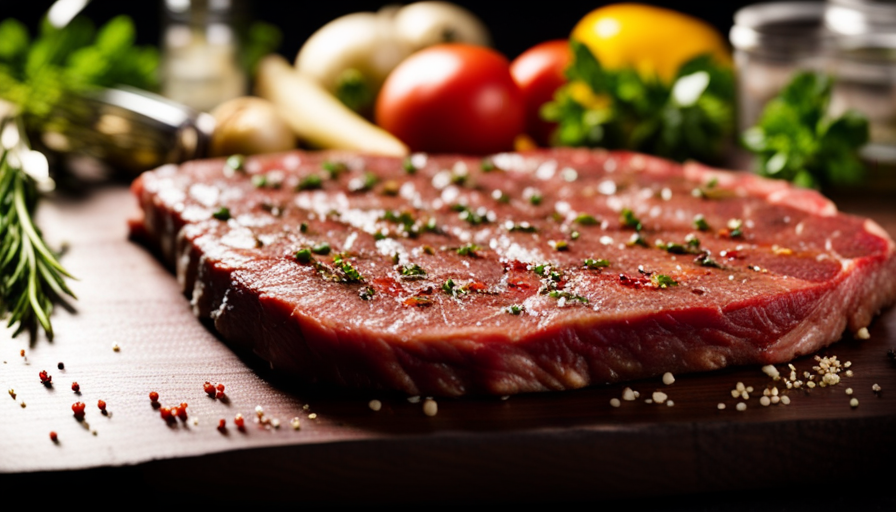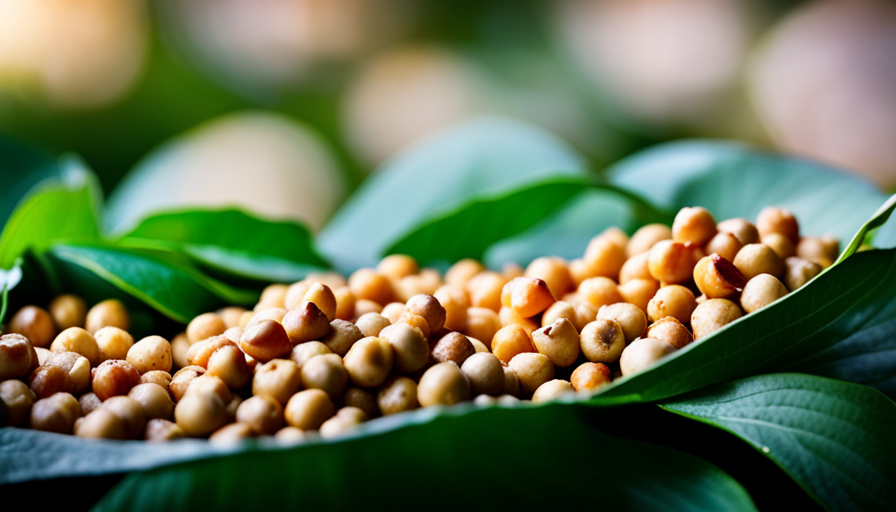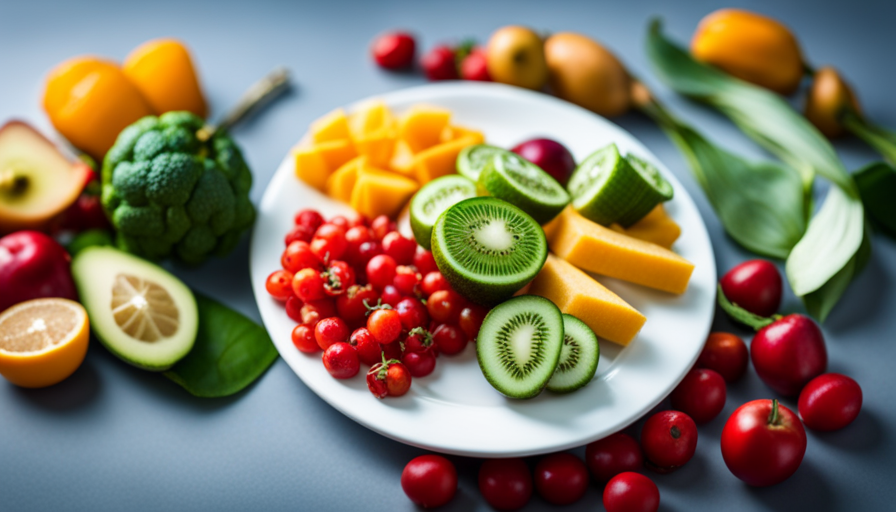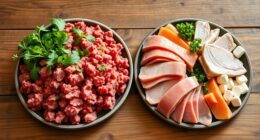When preparing raw chicken, it is essential to prioritize food safety to safeguard yourself and your loved ones from potential illnesses. Adhere to two key food safety guidelines while handling and cooking raw chicken to ensure your well-being and safety.
First and foremost, always remember to wash your hands thoroughly before and after handling raw chicken. This simple act helps to eliminate any potential bacteria that may be present on your hands, preventing cross-contamination.
Secondly, it is vital to use separate cutting boards and utensils for raw chicken. This precautionary measure helps to avoid the transfer of bacteria from the raw chicken to other foods, thus reducing the risk of foodborne illnesses.
By following these two food safety rules, you can significantly reduce the chances of any harmful bacteria causing illness.
Remember, when it comes to cooking raw chicken, it’s better to be safe than sorry. Stay informed, practice proper food handling techniques, and enjoy your delicious, safe meals.
Key Takeaways
- Proper hand hygiene, including washing hands thoroughly with soap and water, is essential to prevent the spread of bacteria when handling raw chicken.
- Using separate cutting boards and utensils for raw chicken can prevent cross-contamination with other ingredients.
- Raw chicken should be stored in the refrigerator at a temperature below 40°F to inhibit bacterial growth.
- Cooking chicken to an internal temperature of 165°F is necessary to ensure that harmful bacteria are killed.
Always wash your hands before and after handling raw chicken
Make sure you wash your hands before and after handling raw chicken to protect yourself and others from potential foodborne illnesses. Hand hygiene is crucial in preventing bacterial contamination.
When we handle raw chicken, we come into contact with bacteria like Salmonella or Campylobacter, which can cause food poisoning if ingested. By washing our hands properly, we can remove these harmful bacteria and reduce the risk of contamination.
To practice proper hand hygiene, start by wetting your hands with clean running water. Apply soap and lather well, making sure to rub your hands together for at least 20 seconds, covering every surface, including the back of your hands, between your fingers, and under your nails. Rinse your hands thoroughly under running water and dry them with a clean towel or air dry them. This simple act can significantly reduce the spread of bacteria and prevent cross-contamination.
Now, let’s move on to the next important food safety rule. It is essential to use separate cutting boards and utensils for raw chicken to avoid cross-contamination. By doing so, we can prevent the transfer of bacteria from the raw chicken to other foods, especially those that will be consumed raw or lightly cooked. This practice ensures that the risk of foodborne illnesses is minimized, and everyone can enjoy a safe and healthy meal.
Use separate cutting boards and utensils for raw chicken to avoid cross-contamination
By using separate cutting boards and utensils for chicken, you can ensure a culinary dance of flavors while avoiding any potential cross-contamination. This simple practice is essential for maintaining food safety when cooking raw chicken. Here are some discussion ideas related to this topic:
-
Proper storage: Raw chicken should be stored in the refrigerator at a temperature below 40°F (4°C) to prevent the growth of harmful bacteria. It’s crucial to keep it in a sealed container or a leak-proof bag to prevent any juices from dripping onto other foods.
-
Cutting techniques: When handling raw chicken, it’s important to follow specific cutting techniques to prevent contamination. Always use a clean and sharp knife to avoid tearing the meat. Additionally, cutting the chicken on a separate cutting board prevents any potential cross-contamination with other ingredients.
-
Sanitization: After using cutting boards and utensils for raw chicken, it’s crucial to wash them thoroughly with hot, soapy water. This helps eliminate any bacteria that may be present, reducing the risk of cross-contamination.
By following these food safety rules, you can create delicious chicken dishes while ensuring the safety of your loved ones. Now, let’s move on to the next section about cooking the chicken to the proper internal temperature of 165°F (74°C) to ensure it’s fully cooked and safe to eat.
Cook the chicken to the proper internal temperature of 165°F (74°C) to ensure it is fully cooked and safe to eat
To ensure the chicken is fully cooked and safe to eat, it’s crucial to cook it to the proper internal temperature of 165°F (74°C). Cooking raw chicken to this temperature kills any harmful bacteria that may be present, reducing the risk of foodborne illnesses.
Using a food thermometer is the best way to accurately measure the chicken’s internal temperature.
Proper cooking temperature is just one aspect of safe handling practices when it comes to cooking raw chicken. It’s important to handle raw chicken carefully to avoid cross-contamination. This means using separate cutting boards and utensils for raw chicken and other ingredients. Cleaning and sanitizing these items thoroughly after use is also essential.
When cooking chicken, it’s important to remember that color alone is not a reliable indicator of doneness. Even if the chicken appears fully cooked on the outside, it may still be undercooked on the inside. Therefore, using a food thermometer to check the internal temperature is crucial.
Avoid thawing raw chicken at room temperature, instead thaw it in the refrigerator or using the defrost function on your microwave. Thawing at room temperature allows bacteria to multiply rapidly, increasing the risk of foodborne illnesses.
By following these guidelines, you can ensure that your chicken is cooked to perfection and safe for consumption.
Avoid thawing raw chicken at room temperature, instead thaw it in the refrigerator or using the defrost function on your microwave
Thawing raw chicken at room temperature can be risky, so it’s best to opt for the refrigerator or microwave defrost function instead. Thawing methods are crucial when it comes to ensuring food safety, and using safe defrosting techniques is essential for preventing the growth of harmful bacteria.
Here are three recommended methods for thawing raw chicken:
-
Refrigerator: Thawing chicken in the refrigerator is the safest method. Simply place the chicken in a leak-proof bag or container and place it on the bottom shelf of the refrigerator. This allows for a gradual thaw, keeping the chicken at a safe temperature while preventing the growth of bacteria.
-
Microwave: If you’re short on time, you can use the defrost function on your microwave. Make sure to follow the manufacturer’s instructions for defrosting poultry. It’s important to immediately cook the chicken after thawing it in the microwave to avoid any risk of bacterial growth.
-
Cold water: If you need to thaw chicken quickly, you can submerge it in cold water. Ensure that the chicken is in a leak-proof bag and change the water every 30 minutes to maintain a cold temperature. Once thawed, cook the chicken immediately.
Thawing raw chicken using these safe methods reduces the risk of bacterial contamination and helps ensure that your chicken is safe to consume.
Now, let’s move on to the next food safety rule: storing raw chicken in a sealed container on the bottom shelf of the refrigerator to prevent any drips or leaks from contaminating other foods.
Store raw chicken in a sealed container on the bottom shelf of the refrigerator to prevent any drips or leaks from contaminating other foods
Storing raw chicken in a sealed container on the bottom shelf of the refrigerator is a simple step that can help prevent any potential drips or leaks from contaminating other foods, ensuring a safer and more organized kitchen. This is an important practice to follow in order to prevent cross-contamination and maintain food safety.
By storing raw chicken in a sealed container, we can minimize the risk of any juices or fluids from the chicken from coming into contact with other foods, which can lead to the spread of harmful bacteria.
Proper storage precautions are crucial when it comes to handling raw chicken. Placing the chicken on the bottom shelf of the refrigerator is advisable because it prevents any possible drips or leaks from reaching other items in the fridge. This prevents cross-contamination and helps to maintain the integrity of other foods. Additionally, using a sealed container provides an extra layer of protection, keeping any potential bacteria contained and reducing the risk of contamination.
By following these storage guidelines, we can ensure that our kitchen remains a safe environment for food preparation.
It’s important to note that proper storage is just one part of food safety when it comes to handling raw chicken. In the next section, we’ll discuss another important rule: not washing raw chicken before cooking as it can spread bacteria through splashing water.
Do not wash raw chicken before cooking as it can spread bacteria through splashing water
Washing raw chicken before cooking? Not a good idea! It’s because splashing water can actually spread bacteria, and we definitely don’t want that in our kitchen.
To ensure food safety, it’s crucial to understand the risks associated with handling raw chicken. One of the most important steps is properly storing raw chicken to prevent contamination. It’s recommended to store raw chicken in a sealed container on the bottom shelf of the refrigerator. This prevents any drips or leaks from contaminating other foods, reducing the risk of cross-contamination.
Another key aspect of food safety when cooking raw chicken is ensuring it is fully cooked. Undercooked chicken can harbor harmful bacteria such as Salmonella or Campylobacter, leading to foodborne illnesses. To ensure that the chicken is fully cooked, it’s essential to use a food thermometer and check that the internal temperature reaches 165°F (75°C). This eliminates any potential bacteria and ensures safe consumption.
Now, let’s talk about marinating raw chicken. It’s important to marinate raw chicken in the refrigerator, not on the counter, to prevent bacteria growth. Marinating on the counter can expose the chicken to the ‘danger zone’ temperature range, between 40°F (4°C) and 140°F (60°C), where bacteria can multiply rapidly. So, when marinating raw chicken, always do it in the refrigerator to maintain food safety.
Marinate raw chicken in the refrigerator, not on the counter, to prevent bacteria growth
When it comes to cooking raw chicken, it’s crucial to follow proper food safety rules. As mentioned earlier, washing raw chicken before cooking is a big no-no because it can actually spread harmful bacteria through splashing water. But that’s not the only precaution you should take.
Another important step to keep in mind is marinating raw chicken in the refrigerator, not on the counter. Preparation methods play a significant role in ensuring the safety of your chicken dish. When marinating chicken, it’s essential to use a clean container and avoid cross-contamination by keeping it separate from other foods. Marinating in the refrigerator helps inhibit the growth of bacteria, as cold temperatures slow down their multiplication. This ensures that your chicken stays safe and free from any harmful pathogens.
Now, it’s time to move on to the next important food safety rule: after cooking chicken, never leave it at room temperature for more than two hours. To avoid any risk of foodborne illness, it’s crucial to refrigerate any leftovers promptly. This helps to preserve the quality of the food while preventing the growth of bacteria.
So, let’s dive into the next subtopic and explore why leaving cooked chicken at room temperature can be a recipe for disaster.
Do not leave cooked chicken at room temperature for more than 2 hours, refrigerate any leftovers promptly
Leftover cooked chicken left out on the counter for too long can become a breeding ground for dangerous bacteria, putting you and your loved ones at risk of foodborne illness. Proper storage of leftover chicken is crucial to ensure its safety and maintain its quality. Here are some important points to consider:
-
Refrigerate promptly: After cooking chicken, it’s essential to refrigerate any leftovers within two hours. This prevents bacteria from multiplying rapidly and reduces the risk of foodborne illness.
-
Use shallow containers: When storing leftover chicken in the refrigerator, use shallow containers. This allows for faster and more even cooling, preventing bacterial growth.
-
Label and date: To keep track of the freshness of your cooked chicken, label and date the containers. This helps you identify how long the leftovers have been stored and when they need to be consumed or discarded.
-
Consume within 3-4 days: While refrigeration slows down bacterial growth, it doesn’t completely stop it. It’s advisable to consume leftover cooked chicken within 3-4 days to ensure its safety and quality.
-
Reheat properly: When reheating leftover chicken, make sure it reaches an internal temperature of 165°F (74°C) to kill any potential bacteria that may have grown.
Discussing the importance of proper storage for leftover chicken and exploring the risks of consuming undercooked chicken highlights the significance of handling and storing poultry correctly. To further prevent foodborne illnesses, it’s crucial to clean and sanitize all surfaces, utensils, and equipment that come into contact with raw chicken to prevent cross-contamination.
Clean and sanitize all surfaces, utensils, and equipment that come into contact with raw chicken to prevent cross-contamination
After learning about the importance of refrigerating cooked chicken promptly, let’s now delve into another crucial food safety rule when it comes to cooking raw chicken: preventing cross-contamination. Cross-contamination occurs when bacteria from raw chicken comes into contact with other foods, surfaces, utensils, or equipment, potentially leading to foodborne illnesses.
To prevent this, it’s essential to clean and sanitize all surfaces, utensils, and equipment that come into contact with raw chicken.
Firstly, wash your hands thoroughly with soap and warm water before and after handling raw chicken. This simple step helps remove any bacteria that may be present on your hands. Additionally, use separate cutting boards and utensils for raw chicken and other foods to avoid cross-contamination.
It’s also crucial to clean and sanitize countertops, sinks, and any other surfaces that may have come into contact with raw chicken.
Moreover, ensure that raw chicken is cooked to the proper internal temperature. The safe internal temperature for chicken is 165°F (74°C). This kills any harmful bacteria that may be present in the meat. Using a food thermometer is the most accurate way to determine if the chicken has reached the correct temperature.
By following these food safety rules, you can greatly reduce the risk of foodborne illnesses associated with raw chicken. It’s vital to prioritize safe food handling practices and stay updated on any food safety recalls or advisories related to chicken products. This will help ensure the health and well-being of yourself and your loved ones.
Educate yourself about safe food handling practices and stay updated on any food safety recalls or advisories related to chicken products
To ensure your safety when handling chicken, it’s important to educate yourself about safe food handling practices and stay updated on any food safety recalls or advisories related to chicken products, as staying informed can significantly reduce the risk of foodborne illnesses.
Did you know that in 2019, there were over 9 million pounds of chicken products recalled due to potential contamination?
Here are some key points to keep in mind:
-
Stay informed: Regularly check for any food safety recalls or advisories related to chicken products. This information is usually available on government websites or through news alerts. By staying updated, you can avoid consuming contaminated chicken and protect yourself and your family from potential health risks.
-
Safe handling: When it comes to chicken, proper handling is crucial. Always wash your hands thoroughly with soap and water before and after handling raw chicken. Use separate cutting boards and utensils for raw chicken to prevent cross-contamination. Make sure to cook chicken to the appropriate internal temperature, which is 165°F (74°C) to kill any harmful bacteria.
-
Avoid consuming undercooked chicken: Undercooked chicken can harbor harmful bacteria like Salmonella and Campylobacter. It’s important to cook chicken thoroughly to ensure it reaches the safe temperature mentioned above. Cut into the thickest part of the meat to check if it’s fully cooked – there should be no pink or red juices, and the meat should be opaque and firm.
-
Proper storage: Store raw chicken in the refrigerator at a temperature below 40°F (4°C). This helps slow down bacterial growth and keeps the chicken fresh until you’re ready to cook it. Additionally, ensure that raw chicken is stored separately from other foods, especially those that won’t be cooked before consuming.
By following these safe food handling practices and staying informed about any food safety recalls or advisories, you can greatly reduce the risk of foodborne illnesses associated with chicken products. Stay safe and enjoy your meals!
Frequently Asked Questions
What is the proper internal temperature for cooking raw chicken?
The proper internal temperature for cooking raw chicken is 165 degrees Fahrenheit. This ensures that any harmful bacteria, such as salmonella, are killed and the chicken is safe to eat.
It’s important to use a food thermometer to accurately measure the temperature. Additionally, cooking time is also crucial. Chicken should be cooked for a sufficient amount of time to reach this temperature throughout, ensuring that it’s fully cooked and safe for consumption.
Why should you avoid thawing raw chicken at room temperature?
You should avoid thawing raw chicken at room temperature because it can promote the growth of bacteria that can cause foodborne illnesses. Thawing chicken at room temperature allows the outer layer to reach a temperature where bacteria can multiply rapidly, while the inside remains frozen.
This uneven thawing process increases the risk of contamination. To prevent this, it’s recommended to thaw raw chicken in the refrigerator or using the defrost setting on a microwave.
What is the recommended storage method for raw chicken in the refrigerator?
Proper storage and safe handling are essential when it comes to raw chicken. It is recommended to store raw chicken in the refrigerator at or below 40°F to ensure its freshness and prevent contamination. This helps inhibit the growth of harmful bacteria. Additionally, always keep raw chicken separate from other foods to avoid cross-contamination. By following these guidelines, you can reduce the risk of foodborne illnesses and promote a healthier cooking environment.
Why should you not wash raw chicken before cooking?
Washing raw chicken before cooking is not recommended due to the potential risks of cross contamination. When water splashes, it can spread bacteria onto kitchen surfaces, utensils, and other foods, increasing the risk of foodborne illnesses.
To ensure food safety, it’s crucial to focus on proper cooking temperatures for chicken. Cooking chicken to an internal temperature of 165°F kills harmful bacteria and ensures that it’s safe to consume.
What should you do if you have leftover cooked chicken?
If I have leftover cooked chicken, there are a few things I can do to ensure its safety. First, I should store it in the refrigerator within two hours of cooking.
When reheating, I can use methods such as microwaving, baking, or sautéing to make sure it reaches an internal temperature of 165°F to kill any bacteria.
Leftover chicken can also be used in creative dishes like salads, sandwiches, or stir-fries, as long as it’s thoroughly reheated.
Can You Give Two Food Safety Rules for Cooking Raw Chicken?
When it comes to food safety rules cooking raw chicken, it’s important to always use separate cutting boards and utensils for raw chicken to prevent cross-contamination. Additionally, ensure that the internal temperature of the chicken reaches at least 165°F to kill any harmful bacteria.
Conclusion
In conclusion, when cooking raw chicken, it’s crucial to prioritize food safety. By following key rules, such as washing hands before and after handling chicken and using separate utensils and cutting boards to prevent cross-contamination, we can ensure a safe and enjoyable meal.
Remember, knowledge is power, so stay informed about food recalls and advisories to protect yourself and your loved ones.
Let’s cook with care and make every meal a delightful experience.










